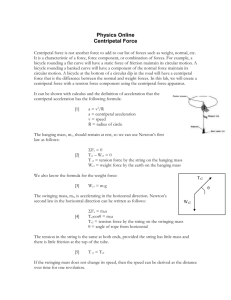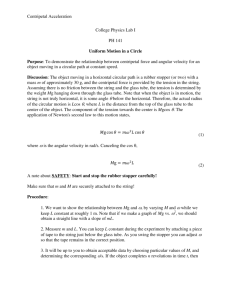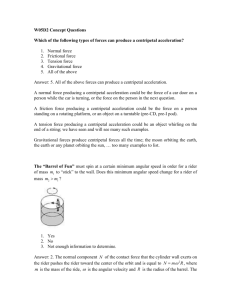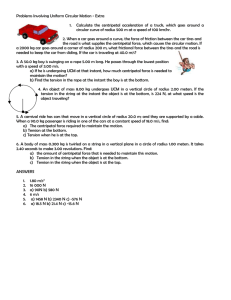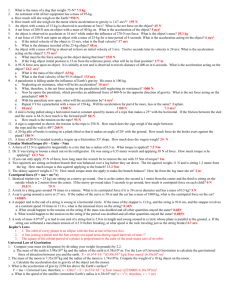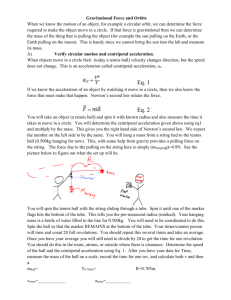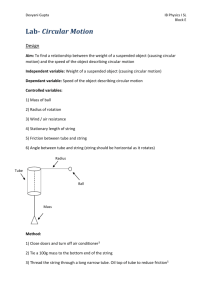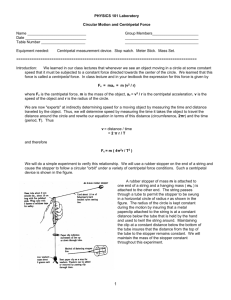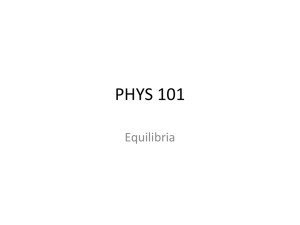Centripetal Force - faculty at Chemeketa
advertisement
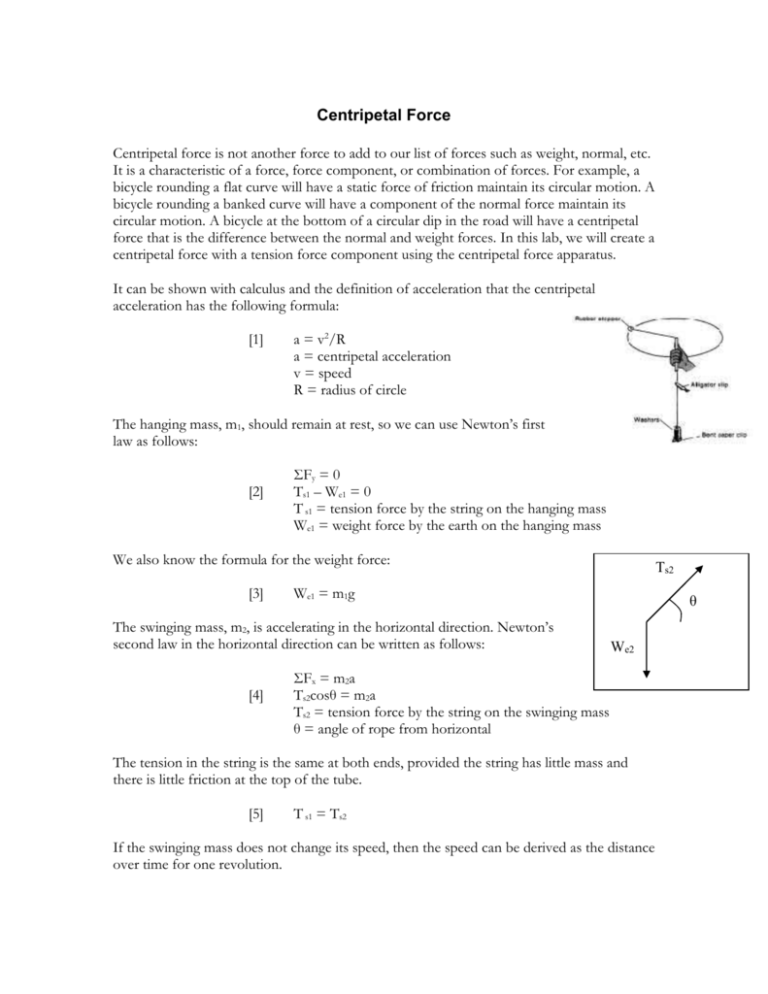
Centripetal Force Centripetal force is not another force to add to our list of forces such as weight, normal, etc. It is a characteristic of a force, force component, or combination of forces. For example, a bicycle rounding a flat curve will have a static force of friction maintain its circular motion. A bicycle rounding a banked curve will have a component of the normal force maintain its circular motion. A bicycle at the bottom of a circular dip in the road will have a centripetal force that is the difference between the normal and weight forces. In this lab, we will create a centripetal force with a tension force component using the centripetal force apparatus. It can be shown with calculus and the definition of acceleration that the centripetal acceleration has the following formula: [1] a = v2/R a = centripetal acceleration v = speed R = radius of circle The hanging mass, m1, should remain at rest, so we can use Newton’s first law as follows: [2] ΣFy = 0 Ts1 – We1 = 0 T s1 = tension force by the string on the hanging mass We1 = weight force by the earth on the hanging mass We also know the formula for the weight force: [3] We1 = m1g The swinging mass, m2, is accelerating in the horizontal direction. Newton’s second law in the horizontal direction can be written as follows: [4] Ts2 θ We2 ΣFx = m2a Ts2cosθ = m2a Ts2 = tension force by the string on the swinging mass θ = angle of rope from horizontal The tension in the string is the same at both ends, provided the string has little mass and there is little friction at the top of the tube. [5] T s1 = Ts2 If the swinging mass does not change its speed, then the speed can be derived as the distance over time for one revolution. [6] v = 2πR/P P = period (time for one revolution) One can use trigonometry to relate the radius to the length of string that goes from the tube to the center of m2. L [7] R/L = cosθ θ R Equations [1] to [7] can be solved for P, the time for one revolution, in terms of the measureable or known L, m1, m2, and g. Lm2 [8] P 2 m1 g Notice that the speed, radius, tension, acceleration, and angle do not appear in the equation for theoretical period. This is desirable since those would be difficult to measure. Physics is fun! Experimental Procedures 1) Obtain two rubber stoppers of significantly different size and measure their masses. The larger mass must be m1, the hanging mass. 2) Hold the tube vertically with one hand, fling m2 with your other hand, and rotate the tube gently so that m2 swings in a circle. You must meet the following criteria before collecting any time data: a. The swinging mass must move at constant speed. b. The swinging mass must move in a horizontal plane. Note that the string need not be horizontal to keep the swinging mass in a horizontal plane. c. The hanging mass must be nearly motionless below the tube. It will swing a little bit and this is unavoidable. d. You must not hold anything except the tube. e. You must not allow anything except the string to touch the bottom of the tube. This includes the alligator clip which is not even necessary for the experiment. f. Avoid strangulation or loss of an eye. 3) Once you have satisfied all of the above criteria, measure the time it takes to complete 20 revolutions. 4) Grab the string at the top of the tube and measure the distance from this point to the center of m2. This is the length, L. 5) Calculate the experimental period by dividing the time by the number of revolutions. 6) Calculate the theoretical period with equation [8]. Be careful with the units you use for L and g. 7) Compare the theoretical and experimental periods. 8) Repeat steps 1 through 7 with a different length by swinging with more or less vigor than previously. 9) Repeat steps 1 through 8 with different mass. This will give you a total of 4 tests. Yes, you will perform 4 tests. This is not a typo. If you do not perform 4 tests, you will not receive full credit on this report. Points to Ponder 1) The error in m1, m2, and g should be fairly small and easily quantified, but the error in L depends on a number of factors. Are you sure that the hanging mass did not move up or down during the 20 revolutions? Did you grab the string before it had a chance to slip? Did the string change its length under tension? Did you measure to the exact center of the swinging mass? If you assess the error in length as the scale limit of the measuring device, then you will not receive full credit on this report. 2) Do not attempt to create or recreate a specific length. If you submit two or more trials with the same length, then I will be very suspicious that you did the lab incorrectly. 3) If experimental and theoretical values do not overlap, then Newton’s second law as applied to circular motion is not supported by this experiment. You should also consider if any assumptions made in deriving equation [8] are not necessarily true. Physics is fun!
